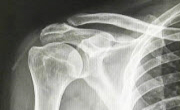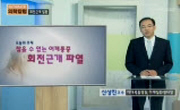목적: 근막 동통 증후군이 동반된 견관절 충돌 증후군 환자에서 근막 동통 증후군의 발생부위와 그 빈도를 알아보고, 충돌 증후군의 치료가 근막 동통 증후군의 동통 개선에 효과가 있는지...
http://chineseinput.net/에서 pinyin(병음)방식으로 중국어를 변환할 수 있습니다.
변환된 중국어를 복사하여 사용하시면 됩니다.
- 中文 을 입력하시려면 zhongwen을 입력하시고 space를누르시면됩니다.
- 北京 을 입력하시려면 beijing을 입력하시고 space를 누르시면 됩니다.
https://www.riss.kr/link?id=A76168329
- 저자
- 발행기관
- 학술지명
- 권호사항
-
발행연도
2005
-
작성언어
Korean
-
주제어
견관절 ; 회전근 개 ; 유발점 ; 근막 동통 증후군 ; 충돌 증후군 ; Shoulder ; Rotator cuff ; Trigger point ; Myofascial pain syndrome ; Impingement syndrome
-
등재정보
KCI등재
-
자료형태
학술저널
- 발행기관 URL
-
수록면
839-844(6쪽)
-
KCI 피인용횟수
1
- 제공처
-
0
상세조회 -
0
다운로드
부가정보
국문 초록 (Abstract)
목적: 근막 동통 증후군이 동반된 견관절 충돌 증후군 환자에서 근막 동통 증후군의 발생부위와 그 빈도를 알아보고, 충돌 증후군의 치료가 근막 동통 증후군의 동통 개선에 효과가 있는지를 알아보고자 하였다.
대상 및 방법: 근막 동통 증후군으로 진단된 견관절 충돌 증후군 환자 중 외래에서 견갑골 주위 근육에 통증을 호소한 환자 53명을 대상으로 하였다. 치료 방법에 따라 대상 환자는 세 군으로 나누었다. 견봉하 주사를 시행한 군, 견갑골 주위 근육과 회전근 개의 등장성 근력강화 운동만 실시한 군, 보존적 치료에 실패하여 수술적 가료를 시행한 군. 대상 환자 모두 치료 전에 이학적 검사를 통해서 근막 동통 증후군의 위치를 확인하였고 관절 주위 동통 및 견관절의 운동범위를 측정하였으며 기능적 평가는 ASES 견관절 점수를 이용하였다.
결과: 근막 동통 증후군의 발생 부위, 연령, 성별, 충돌 징후, 관절 주위 압통은 운동범위 및 기능적 정도와 연관성을 보이지 않았다. 동통의 정도는 VAS가 치료 전 6.2±2.3에서 치료 후 1.2±1.5로 의미 있게 감소하였고(p<0.01), ASES 견관절 점수도 치료 전 32.1±15.3에서 치료 후 87.5±17.7로 의미 있게 증가되었다(p<0.05). 그러나 동통 및 ASES 견관절 점수 모두 치료 방법을 달리한 세 군간에 차이를 보이지는 않았다(p>0.05).
결론: 견관절 충돌 증후군의 치료로 근막 동통 증후군의 증상이 호전되는 결과로 볼 때 견관절 충돌 증후군이 근막 동통 증후군의 원인으로 작용할 가능성이 있는 것으로 생각된다.
다국어 초록 (Multilingual Abstract)
Purpose: In order to study the frequency and the site of pain with shoulder impingement syndrome accompanied by myofascial pain syndrome (MPS), and to see how the treatment of impingement syndrome effects the improvement in myofascial pain. Materia...
Purpose: In order to study the frequency and the site of pain with shoulder impingement syndrome accompanied by myofascial pain syndrome (MPS), and to see how the treatment of impingement syndrome effects the improvement in myofascial pain.
Materials and Methods: Among patients diagnosed with shoulder impingement syndrome with MPS and who complained around of shoulder muscle pain 53 subjects were selected as subjects for this study. Patients were divided into three groups according to method of treatment; the first group was the cases who received impingement injection test, the second group were only carried out isometric strengthening exercise of the periscapular muscles and the rotator cuff, and the third group was the cases who failed conservative treatment and had a surgical operation. All subjects had a physical examination before treatment to see if the MPS was present in the muscles around the shoulder, the range of motion of shoulder, and the American Shoulder and Elbow Society (ASES) shoulder score were measured.
Results: There was no relation to between age, gender, impingement signs, tenderness around the joints, the range of motion and ASES shoulder score. The VAS was reduced from 6.2±2.3 to 1.2±1.5 (p<0.01), and ASES shoulder score increased from 32.1±15.3 to 87.5±17.7 (p<0.05). The differences among treatments of the three groups were not significant in pain and treatment outcome (p>0.05).
Conclusion: Treatment of shoulder impingement syndrome reduced the symptoms of MPS, thus shoulder impingement syndrome can be the one of the causes of MPS.
참고문헌 (Reference)
1 "treatment by intramuscular infiltration withprocaine hydrochloride. JAMA" 417-422, 1942.
2 "The present status of neuromuscular thermography.Postgrad Med" 26-33, 1986.
3 "Tests of functional limitations in fibromyalgia syndrome" 12 : 193-199, 1999.
4 "Shoulder impingement in tennis/racquetball playerstreated with subscapularis myofascial treatments. Arch Phys MedRehabil" 679-682, 2000.
5 "Scapulothoracic musclefatigue associated with alterations in scapulohumeral rhythmkinematics during maximum resistive shoulder elevation. J OrthopSports Phys Ther" 28 : 74-80, 1998.
6 "Myofascial pain syndrome. Primary care strategies for early intervention. Postgrad Med" 56-59, 1994.
7 "Myofascial origins of low backpain. 3. Pelvic and lower extremity muscles. Postgrad Med" 99-105, 1983.
8 "Myofascial origins of low backpain. 2. Torso muscles. Postgrad Med" 81-92, 1983.
9 "Myofascial origins of low back pain.1. Principles of diagnosis and treatment. Postgrad Med" 68-70, 1983.
10 "Muscular endurance and electromyographicfatigue in myofascial shoulder pain. Arch Phys MedRehabil" 522-525, 1984.
1 "treatment by intramuscular infiltration withprocaine hydrochloride. JAMA" 417-422, 1942.
2 "The present status of neuromuscular thermography.Postgrad Med" 26-33, 1986.
3 "Tests of functional limitations in fibromyalgia syndrome" 12 : 193-199, 1999.
4 "Shoulder impingement in tennis/racquetball playerstreated with subscapularis myofascial treatments. Arch Phys MedRehabil" 679-682, 2000.
5 "Scapulothoracic musclefatigue associated with alterations in scapulohumeral rhythmkinematics during maximum resistive shoulder elevation. J OrthopSports Phys Ther" 28 : 74-80, 1998.
6 "Myofascial pain syndrome. Primary care strategies for early intervention. Postgrad Med" 56-59, 1994.
7 "Myofascial origins of low backpain. 3. Pelvic and lower extremity muscles. Postgrad Med" 99-105, 1983.
8 "Myofascial origins of low backpain. 2. Torso muscles. Postgrad Med" 81-92, 1983.
9 "Myofascial origins of low back pain.1. Principles of diagnosis and treatment. Postgrad Med" 68-70, 1983.
10 "Muscular endurance and electromyographicfatigue in myofascial shoulder pain. Arch Phys MedRehabil" 522-525, 1984.
11 "Infrared skin temperaturemeasurement cannot be used to detect myofascial tender spots. ArchPhys Med Rehabil" 82 : 902-905, 2001.
12 "Huh BY and Yoo TW Shoulder functiontest in myofascial pain syndrome. Korean Acad Rehab Med" 368-374, 1995.
13 "Effects of local musclefatigue on three-dimensional scapulohumeral rhythm. ClinBiomech" 144-148, 1995.
14 "Documentation of myofascial trigger points. ArchPhys Med Rehabil" 286-291, 1988.
15 "Arthroscopic capsular release for stiff shoulders effect of etiology on outcomes. Arthroscopy" 40-49, 2003.
16 "A standardized methodfor the assessment of shoulder function. J Shoulder Elbow Surg" 347-352, 1994.
동일학술지(권/호) 다른 논문
-
- 대한정형외과학회
- 박명문
- 2005
- KCI등재
-
- 대한정형외과학회
- 강호정(Ho-Jung Kang)
- 2005
- KCI등재
-
후방 전위된 불안정성 요골 원위부 골절의 전방 금속판 고정술을 이용한 수술적 치료
- 대한정형외과학회
- 남일현(Il Hyun Nam)
- 2005
- KCI등재
-
견봉 쇄골 관절 병변에 대한 관절경 보조 하 원위 쇄골 en bloc 절제술
- 대한정형외과학회
- 박태수(Tae-Soo Park)
- 2005
- KCI등재
분석정보
인용정보 인용지수 설명보기
학술지 이력
| 연월일 | 이력구분 | 이력상세 | 등재구분 |
|---|---|---|---|
| 2026 | 평가예정 | 재인증평가 신청대상 (재인증) | |
| 2020-04-14 | 학회명변경 | 영문명 : 미등록 -> The Korean Orthopaedic Association |  |
| 2020-01-01 | 평가 | 등재학술지 유지 (재인증) |  |
| 2017-01-01 | 평가 | 등재학술지 유지 (계속평가) |  |
| 2014-01-14 | 학술지명변경 | 외국어명 : 미등록 -> Journal of the Korean Orthopaedic Association |  |
| 2013-01-01 | 평가 | 등재학술지 유지 (등재유지) |  |
| 2010-01-01 | 평가 | 등재 1차 FAIL (등재유지) |  |
| 2008-01-01 | 평가 | 등재학술지 유지 (등재유지) |  |
| 2005-05-30 | 학술지등록 | 한글명 : 대한정형외과학회지외국어명 : 미등록 |  |
| 2005-01-01 | 평가 | 등재학술지 선정 (등재후보2차) |  |
| 2004-01-01 | 평가 | 등재후보 1차 PASS (등재후보1차) |  |
| 2002-07-01 | 평가 | 등재후보학술지 선정 (신규평가) |  |
학술지 인용정보
| 기준연도 | WOS-KCI 통합IF(2년) | KCIF(2년) | KCIF(3년) |
|---|---|---|---|
| 2016 | 0.06 | 0.06 | 0.08 |
| KCIF(4년) | KCIF(5년) | 중심성지수(3년) | 즉시성지수 |
| 0.08 | 0.08 | 0.24 | 0.01 |




 DBpia
DBpia



